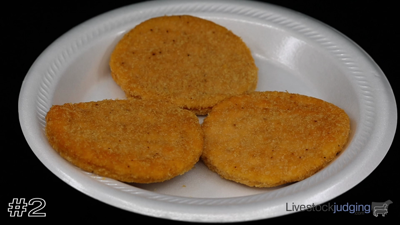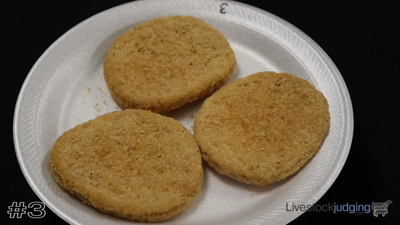Boneless Further Processed
Coating Void
Defects are identified by continuous voids exceeding the allowed limit, specifically more than ¼ inch on tenders and nuggets and more than ½ inch on patties, with the amount of void not being additive over multiple pieces.
Inconsistent Color
Subtle differences in color are normal. If one of the products in a group is noticeably darker or lighter than the others, it is considered a color defect, and for single items, the color must be uniform without dark, burnt, or contrasting areas in the coating.
Inconsistent Shape / Size
While slight variations in the size and shape of boneless chicken products are normal, substantial differences can impact consumer preferences and cooking times. If there are clear inconsistencies in size or shape, or if a product is folded and takes on an inconsistent shape compared to other samples, this should be marked.
Broken / Incomplete
Broken or incomplete products in meat processing can be evident in two ways: an incomplete break where a tear in the meat is visible, and a complete break where the product is in two pieces or part of the piece. Even if only part of the broken item is displayed, it should be recorded as "Broken/Incomplete," and it should not be classified under "Inconsistent Shape and Size" or "Coating Defect" if the break itself caused these apparent defects.
Cluster / Marriages
To be classified as a "Cluster" defect, the products must appear to be fused together with breading, not merely touching or overlapping when displayed.
Foreign Material
Foreign materials in food include any non-food objects like feathers, plastic, metal, rubber, glass, and wood. Bones within meat products are not classified as foreign material, as they are considered a natural part of the carcass.
No Defect
Record "No Defect" if none of the above issues are present.

2023 SALE #7
Boneless class graded by TAMU judges

2023 PSS #2
This class has been viewed 30 times over the past month

2024 PSS #7
This class has been viewed 138 times over the past month

2022 Paris #5
This class has been viewed 32 times over the past month

2024 PSS #7
This class has been viewed 34 times over the past month

2022 Alvin #2
This class has been viewed 12 times over the past month

2023 PSS #7
This class has been viewed 16 times over the past month

2020 Klein #3
This class has been viewed 12 times over the past month